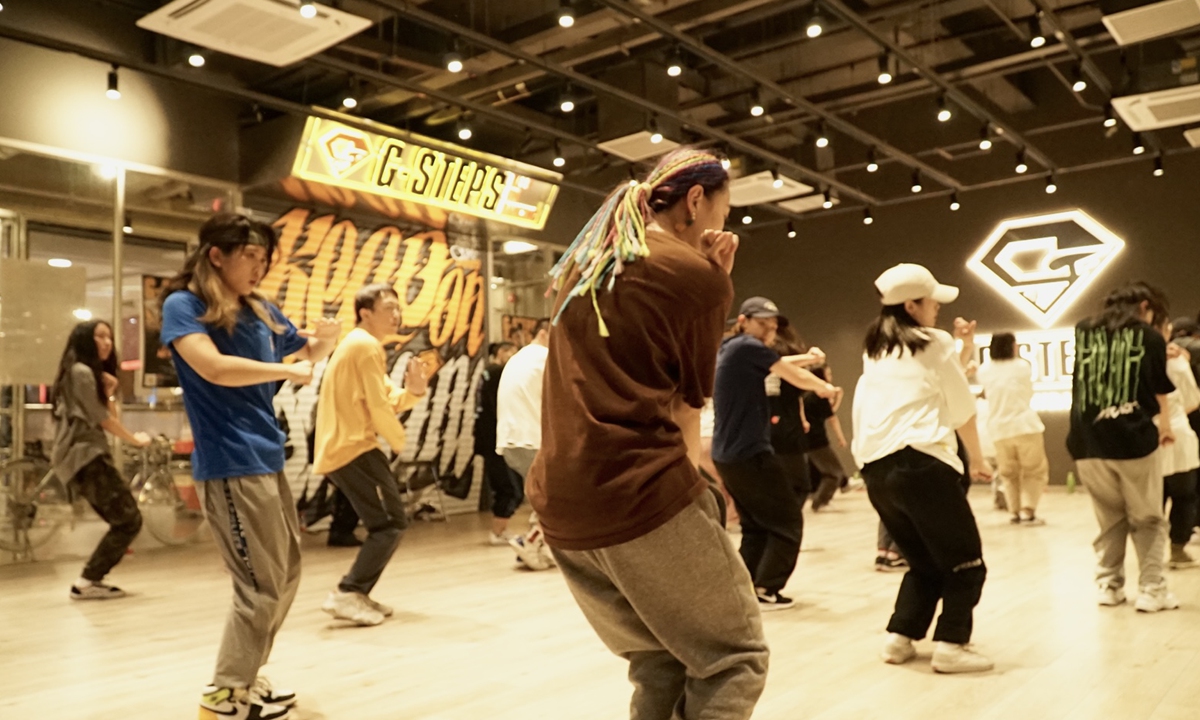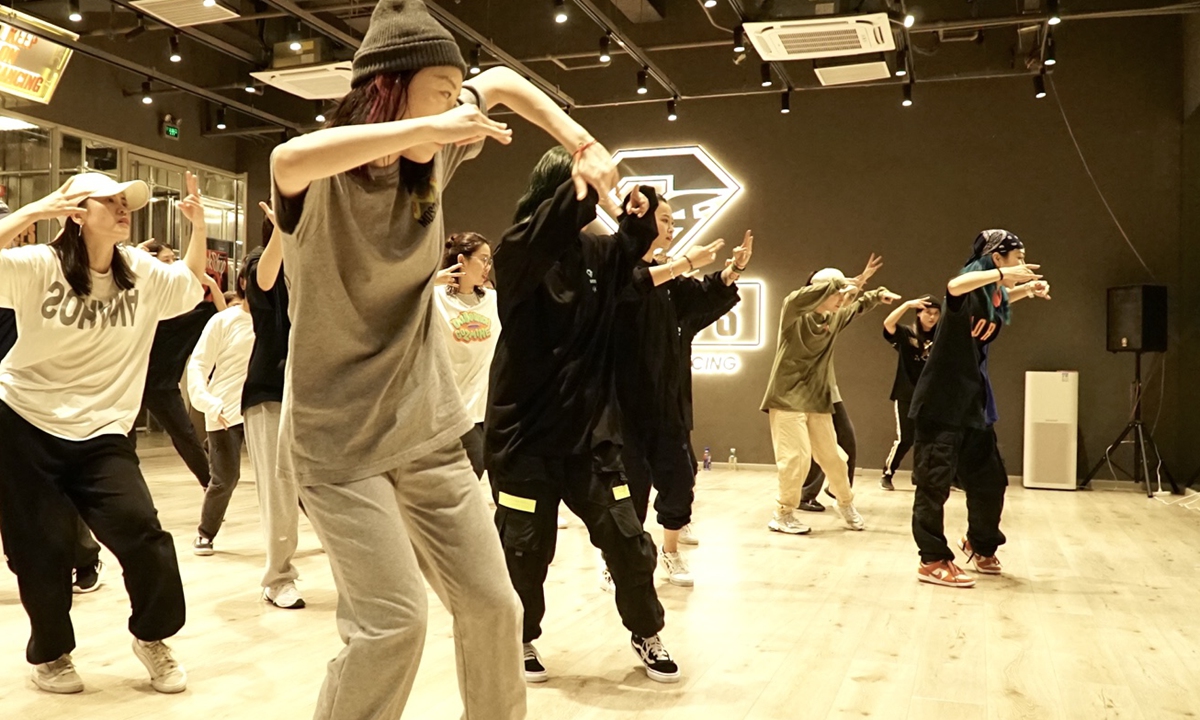
Photo: Yang Wenyu/GT
Just like idol groups shine on stage, many young people in China also dance on their own stages in daily life. Dancing has gradually become a new lifestyle for Generation Z in China in recent years due to the popularity of talent shows and the influence of global popular culture.
Becoming a trend
Deng Munan puts on comfortable sportswear after work and heads to the nearby dance studio. The dance coach asks everyone to shoot a dance video before the end of the class, and Deng posts the resulting video on her own social media account.
An accountant working in East China's Shanghai, Deng usually takes one-hour dance class after a day of work.
"I have been learning how to dance for half a year and usually take classes four times a week. Sometimes I even practice six times a week. When I get stuck with work, I have to cut some classes, but I still dance at least once a week," 24-year-old Deng, who is a fan of K-pop culture and has a lot of friends also studying dance, told the Global Times.
The increasing popularity of dance has led to new studios popping up all the time.
"Our dance studio has been open for 17 years and has 14 campuses in Beijing. It is obvious that a surging number of people have been taking dance courses in recent years," said Zi Xu, a course consultant at the Beijing-based Yufei Dance School, from which more than 50,000 dance students have graduated.
"The majority of students here are girls, and K-pop and jazz courses are their favorites," said another course consultant surnamed Li with the Xuanwu Dance Studio, which has been in operation for nine years and has four branches in Beijing.
Due to the large number of students, most dance studios in mega Chinese cities as Beijing and Shanghai utilize class reservation systems, in which students can make reservations through mini apps or studios' official accounts on WeChat. When reservations exceed a set limit, the extra students are automatically put on a waiting list.
"I make reservations immediately when the system updates classes, otherwise I may not be able to attend the classes I like. Sometimes the number of people on the waiting list can reach 40. It feels like trying to get train tickets during the holidays," said a student surnamed Zhang at the G-Steps Dance Studio, a chain dance studio with more than 2,000 students in Beijing.
Whenever popular K-pop stars or idol groups such as Kim Hyun-a, Blackpink or Red Velvet release new songs, classes become even more popular and so studios will often increase the amount of services they are offering.

Photo: Yang Wenyu/GT
K-pop influences
Dances from K-pop music videos are a favorite for female dance students due to the great influence of K-pop culture and the rising popularity of talent shows in China. The choreography of some of the dances combines various styles such as jazz and hip-hop.
"I am a fan of many South Korean idol groups like Twice and Red Velvet, and I can't wait to learn their dances whenever new songs are released," Deng said.
"I started to study dance because I am a super fan of Blackpink," 25-year-old Lin Ran, who works for an internet company in Beijing and has been following the globally trendy girl group since 2017, told the Global Times.
A representative K-pop group, Blackpink has millions of followers in China like Lin and Deng. Lisa, a Blackpink member from Thailand, also participated in the second and third season of China's hit talent show Youth With You as a mentor, which helped her gain even more followers in the country.
In addition to dances from K-pop music videos, dances by Chinese idol groups have also become popular with the emergence of a growing number of talent shows and Chinese idol groups.
Most dances from music videos do not involve difficult dance moves or require great dance skills, but rather focus more on showing feminine charm and expressing emotions. This accessibility makes these dances easy for amateur dance students to learn, which in turn causes them to spread among people more rapidly.
"I have a basic grasp of dance since I studied folk dance for five or six years when I was a child. Music video dances are relatively easy as well, so I don't find them discouraging, unlike learning ballet."
Most people find the price of dance classes reasonable. The average price of a class was around 70-100 yuan ($11-15) at the dance studios in Beijing and Shanghai that the Global Times reached.
A way to socialize
Dancing has gradually become an entertaining way to work out, increase people's confidence and give them a sense of accomplishment. Additionally, it is improving people's social lives.
"I want to develop a good figure, and dancing is more fun and easier for me to stick to than working out," Lin replied when asked why she keeps dancing.
For Wang Yuting, a graduate student in medicine who works as an intern in Beijing, dancing is her best way to relieve stress.
"It is like a key that switches my moods and relaxes me," she noted.
Wang likes to share dance videos on her WeChat Moments page, which gives her a great sense of accomplishment.
"I feel more valuable and motivated when my friends watch a dance routine that I have practiced so hard to learn," she noted.
Yang Xiaoyi, who used to be a member of the street dance club at Nankai University in North China's Tianjin, said she feels that learning how to dance has given her courage.
"I used to be shy. When I saw the street dance club perform on stage, I felt a type of power, which gave me great impetus to join the club. Gradually, I found myself becoming more confident," said Yang.
Dancing has even become a way for her to socialize.
"I got to know a lot of friends at the dance club. Besides dancing, I have learned various skills from my dance club friends, including makeup skills and photography, which has made my campus life richer and happier," Yang said.



